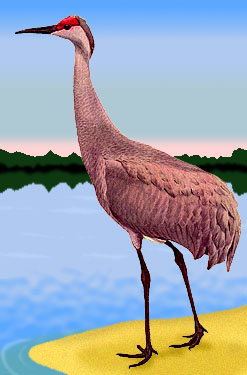
Sandhill Crane - (Grus canadensis)
 Mature Sandhill Crane
Mature Sandhill Crane
|
OTHER NAMES:
Brown Crane; Upland Crane; Field Crane; Southern Sandhill Crane.
|
GENERAL DESCRIPTION:
Length, 4 feet; spread of wings, 6 and 1/2 feet. Plumage, slaty-gray. Head with bare spot forking behind, not reaching on sides below eyes, and thinly sprinkled with hair.
|
ADULT:
Plumage, slaty-gray; primaries and their coverts, ashy-gray, but little darker than general color; cheeks and throat, lighter inclined to whitish; bill and feet, black; iris, brown. |
YOUNG:
Head, feathered. Plumage, variegated with rusty and brown.
|
NEST:
On the ground, usually
on a slight knoll of open grassy flats; generally a mere depression in the ground, lined with dry grass and weed stems. |
EGGS:
2, from pale olive to buffy-brown, marked over entire surface with spots of burnt-umber.
|
| |
 Distribution: Distribution:
North America; resident in Louisiana and Florida; bred formerly from southern British Columbia, Saskatchewan, Manitoba, and western Ontario south to California, Colorado, Nebraska, Illinois, and Ohio; formerly in migration east to New England; now rare east of the Mississippi, except in Florida, and rare as a breeder in the southern half of its former breeding range; winters from California, Texas, and Louisiana south to Mexico. |
The virtual extermination, or at best the extreme rarity, of the great Whooping Crane, leaves the much smaller Sandhill Crane by far the largest representative of that interesting family in America. For it should be remembered that the various Herons-notably the Great Blue Heron - which are commonly called "Cranes," not only are not Cranes at all, but differ radically from them in both disposition and habits.
If not in size, then in its conspicuous and striking characteristics, the Sandhill Crane is a fit successor to his towering relative, whose days seem to be numbered. Nor is the bird a weakling at that, for the height of the male when he stands erect is nearly that of a man of average stature, while the bird's great wings carry his compact and muscular body with perfect ease and at a high speed. The bird's wariness bespeaks intelligent caution rather than weakness or fear.
Indeed, when the Sandhill Crane is crippled by a broken wing or otherwise, he may become an exceedingly ugly antagonist for the man who attempts to overpower him, because of the skill, strength, and quickness with which he will then employ his long and dagger-like bill in defending himself. Many a hunter's dog has been blinded or otherwise badly injured by the vicious thrusts of this very dangerous weapon, which the Crane does not hesitate to use when he is at bay and fighting for his life.
Unlike the Herons, this Crane spends much of its time, and gets the food which it seems to relish most, on dry land. Hence it is often found on the plains and prairies, sometimes in small flocks but oftener in pairs or singly. Its diet includes a large percentage of roots, bulbs, grains, and the like; and it is especially fond of corn which it: takes from the shock. Insects, frogs, lizards, snakes, and mice are also included in its bill of fare, but not in sufficient numbers to make its flesh "strong" as is that of the Herons and other wading birds. In fact, this Crane's flesh is excellent for the table, and it has been persistently hunted for food.
On the fenceless prairies and the treeless marshes, where its keen eyes can detect afar off the approach of an enemy, the demeanor and habits of this fine, brave bird challenge the admiration of the man who appreciates alertness, courage, and strength in wild life. Not for an instant is the great bird off his guard. Moving in deliberate and dignified strides he pauses occasionally and lowers his head to thrust his long bill into the soft earth, or to seize a dozing frog or an unwatchful insect;but in a few seconds up again comes his head, and his eyes search the surrounding country. If the approach of his chief enemy, man, is discovered, the Crane surveys the intruder for a few minutes and then, with a few long, running strides takes to his
wings, at the same time sounding his wild and defiant cry.
This cry of the Sandhill Crane is a veritable voice of Nature, untamed and unterrified. Its uncanny quality is like that of the Loon, but is more pronounced because of the much greater volume of the Crane's voice. Its resonance is remarkable and its carrying power is increased by a distinct tremolo effect. Often for several minutes after the birds have vanished, the unearthly sound drifts back to the listener, like a taunting trumpet from the under-world.
The Little Brown Crane (Grus canadensis) is
like the Sandhill Crane except for its smaller size. It breeds from northern Alaska, Melville Island, and Boothia Peninsula south to central Alaska, southern Mackenzie, and central Keewatin. During migration it occurs through the interior of the United States and winters south to Texas and Mexico.
| Cranes | Long -Legged Waders | Home | Bird Classifications |
|


 Distribution:
Distribution: